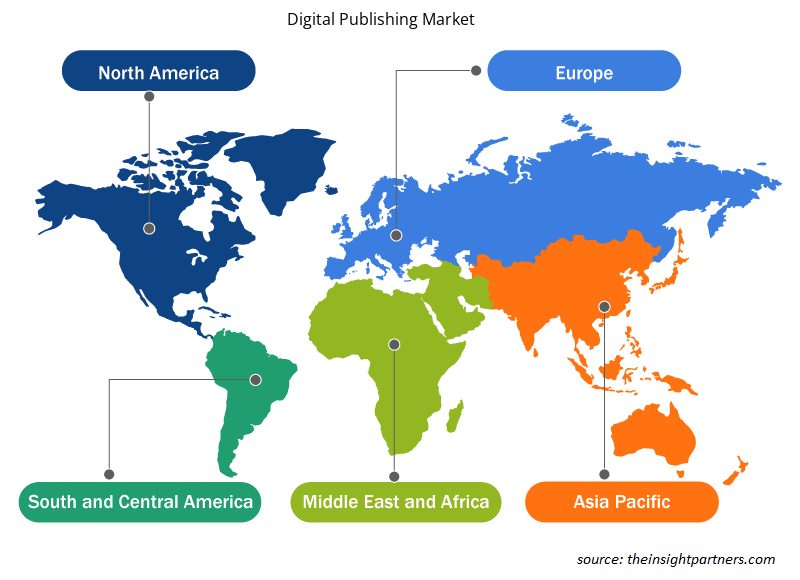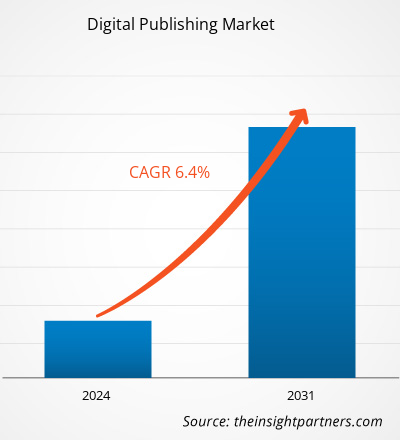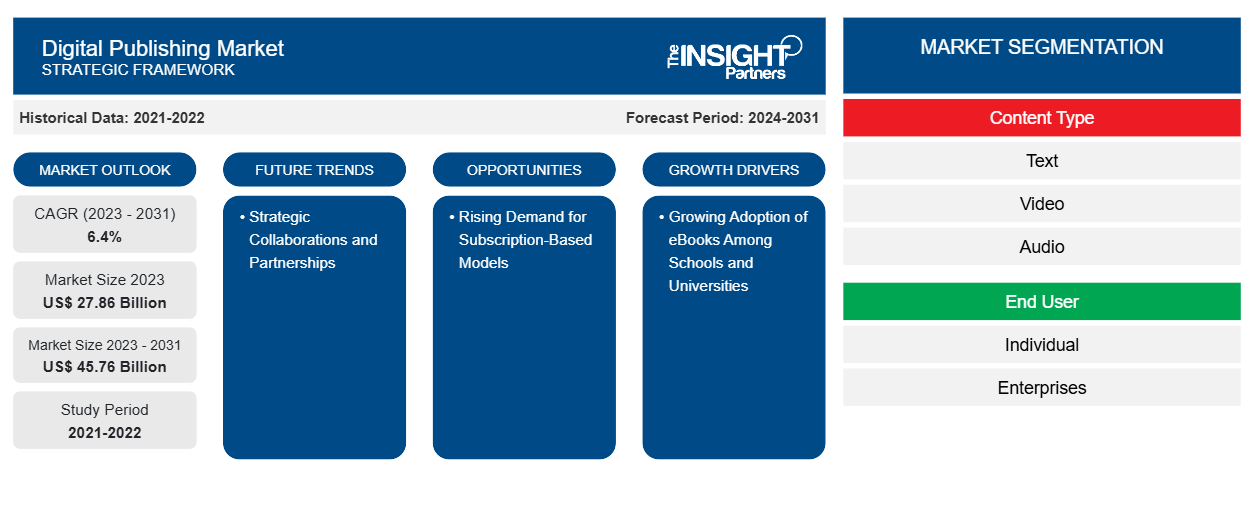Le marché de l'édition numérique devrait atteindre 45,76 milliards de dollars d'ici 2031, contre 27,86 milliards de dollars en 2023. Le marché devrait enregistrer un TCAC de 6,4 % au cours de la période 2023-2031. Les collaborations et partenariats stratégiques devraient rester une tendance clé du marché.
Analyse du marché de l'édition numérique
L’édition numérique remplace rapidement la méthode traditionnelle d’édition imprimée. De plus, la pandémie de COVID-19 a également alimenté l’augmentation des médias numériques ainsi que d’autres facteurs favorisant la croissance de l’édition numérique. Les éditeurs augmentent rapidement la distribution et élargissent leurs sources de revenus actuelles en choisissant l’édition numérique. Outre les facteurs ci-dessus, plusieurs nouvelles fonctionnalités d’édition numérique devraient avoir un impact sur la croissance de l’édition numérique au cours des 6 à 7 prochaines années. Par exemple, la documentation et la simplicité de mise en œuvre du produit, ainsi que les performances et l’expérience utilisateur qui sont rapides et simples d’accès, entraînent le besoin de contenu original ou de contenu généré par les utilisateurs pour fidéliser les utilisateurs, monétiser le contenu et intégrer le commerce électronique.
Aperçu du marché de l'édition numérique
L'édition numérique, également appelée édition électronique ou en ligne, consiste à diffuser divers contenus en ligne tels que des revues, des magazines, des journaux et des livres électroniques. En suivant ce processus, toute entreprise ou entité d'édition peut convertir des documents et des données papier en format numérique, qui peuvent être consultés en ligne, téléchargés, modifiés et imprimés ou partagés à la discrétion des utilisateurs.
Personnalisez ce rapport en fonction de vos besoins
Vous bénéficierez d'une personnalisation gratuite de n'importe quel rapport, y compris de certaines parties de ce rapport, d'une analyse au niveau des pays, d'un pack de données Excel, ainsi que de superbes offres et réductions pour les start-ups et les universités.
- Obtenez les principales tendances clés du marché de ce rapport.Cet échantillon GRATUIT comprendra une analyse de données, allant des tendances du marché aux estimations et prévisions.
Facteurs moteurs et opportunités du marché de l'édition numérique
L'adoption croissante des livres électroniques dans les écoles et les universités favorise le marché
Les livres numériques aident les établissements d’enseignement à atteindre trois objectifs stratégiques principaux : améliorer l’expérience des étudiants et leurs résultats scolaires dans un environnement plus compétitif, favoriser l’innovation dans l’enseignement, l’apprentissage et la recherche, et contribuer à une utilisation optimale des ressources en espace et en personnel. Pour les universités et leurs bibliothèques, un problème de longue date est de garantir la disponibilité en temps voulu des livres importants, la principale plainte des étudiants dans les enquêtes étant souvent le nombre insuffisant d’exemplaires. Les étudiants peuvent facilement accéder aux livres numériques à tout moment et depuis n’importe quel endroit, ce qui en fait une option pratique qui répond à leurs attentes de manière plus efficace.
En outre, les progrès croissants dans l’éducation, la formation et l’exploration ont un impact sur l’adoption mondiale de l’édition numérique. Par exemple, l’Université de Leicester propose le MSc en sécurité, conflits et développement international par le biais de l’apprentissage en ligne. Le Département de criminologie propose un programme adapté aux personnes travaillant ou souhaitant travailler dans le secteur du développement international. Les étudiants de ce programme peuvent travailler dans des environnements militaires, dans des régions éloignées ou en tant que soldats de la paix, loin d’une salle de classe typique. Chaque étudiant reçoit un iPad contenant des supports de cours, des livres électroniques et une application de cours pour y accéder. Les étudiants peuvent accéder à ces livres électroniques et les lire même lorsque leur lieu de travail ne dispose pas d’une connexion Internet fiable, qui peut souvent être indisponible ou peu fiable. L’utilisation croissante des livres électroniques dans les établissements d’enseignement stimule l’expansion de l’industrie mondiale de l’édition numérique.
Demande croissante pour les modèles basés sur l'abonnement
L’évolution de l’environnement en ligne exige de la flexibilité, ce qui incite les éditeurs à diversifier leurs sources de revenus. Ils recherchent de nouvelles façons d’assurer leur stabilité financière, en allant au-delà des modèles habituels de publicité et d’abonnement. Cette nouvelle stratégie se décline sous différentes formes : par le biais de partenariats de contenu sponsorisé, où les marques collaborent sur du contenu pertinent, ou de marketing d’affiliation, où les éditeurs gagnent de l’argent en commercialisant des produits ou des services et en gagnant des commissions. L’organisation d’événements ou la création de cours en ligne offrent des moyens directs d’interagir avec les lecteurs. Cela crée un lien plus profond et la possibilité de générer davantage de revenus. Les éditeurs réévaluent leurs méthodes actuelles, en cherchant à personnaliser et à répondre aux besoins de chaque utilisateur. Les micropaiements, de plus en plus populaires, permettent aux lecteurs de payer une somme modique pour des articles individuels plutôt que de s’engager dans des services d’abonnement complets, offrant ainsi plus de flexibilité et répondant à des habitudes de consommation variées.
Analyse de segmentation du rapport sur le marché de l'édition numérique
Les segments clés qui ont contribué à l’élaboration de l’analyse du marché de l’édition numérique sont le type de contenu et l’utilisateur final.
- En fonction du type de contenu, le marché est segmenté en texte, vidéo et audio. Le segment vidéo détenait une part de marché importante en 2023.
- En termes d'utilisateur final, le marché est divisé en deux catégories : les particuliers et les entreprises. Le segment des particuliers détenait une part substantielle du marché en 2023.
Analyse des parts de marché de l'édition numérique par zone géographique
La portée géographique du rapport sur le marché de l’édition numérique est principalement divisée en cinq régions : Amérique du Nord, Asie-Pacifique, Europe, Moyen-Orient et Afrique, et Amérique du Sud et centrale.
L’Amérique du Nord devrait détenir une part importante du marché de l’édition numérique en 2023. L’augmentation prévue de la demande pour le marché de l’édition numérique dans cette région est motivée par le besoin croissant de publications numériques améliorées. Les principaux leaders du marché tels qu’Adobe Inc., Apple Inc., Amazon.com Inc., Alphabet Inc. et d’autres s’engagent dans des partenariats, des acquisitions et le développement de nouveaux produits et améliorations, ce qui stimule la croissance du marché dans la région. Un exemple est lorsque Comcast Inc. a dévoilé une nouvelle solution en mars 2021 pour se connecter à la gestion centralisée des campagnes publicitaires pour la télévision.Amazon.com Inc., Alphabet Inc., and others are engaging in partnerships, acquisitions, and the development of new products and enhancements, which is driving market growth in the region. An example is when Comcast Inc. unveiled a new solution in March 2021 to connect with centralized advertising campaign management for television.
Aperçu régional du marché de l'édition numérique
Les tendances et facteurs régionaux influençant le marché de l’édition numérique tout au long de la période de prévision ont été expliqués en détail par les analystes d’Insight Partners. Cette section traite également des segments et de la géographie du marché de l’édition numérique en Amérique du Nord, en Europe, en Asie-Pacifique, au Moyen-Orient et en Afrique, ainsi qu’en Amérique du Sud et en Amérique centrale.

- Obtenez les données régionales spécifiques au marché de l'édition numérique
Portée du rapport sur le marché de l'édition numérique
| Attribut de rapport | Détails |
|---|---|
| Taille du marché en 2023 | 27,86 milliards de dollars américains |
| Taille du marché d'ici 2031 | 45,76 milliards de dollars américains |
| Taux de croissance annuel composé mondial (2023-2031) | 6,4% |
| Données historiques | 2021-2022 |
| Période de prévision | 2024-2031 |
| Segments couverts | Par type de contenu
|
| Régions et pays couverts | Amérique du Nord
|
| Leaders du marché et profils d'entreprises clés |
|
Densité des acteurs du marché de l'édition numérique : comprendre son impact sur la dynamique des entreprises
Le marché de l'édition numérique connaît une croissance rapide, tirée par la demande croissante des utilisateurs finaux en raison de facteurs tels que l'évolution des préférences des consommateurs, les avancées technologiques et une plus grande sensibilisation aux avantages du produit. À mesure que la demande augmente, les entreprises élargissent leurs offres, innovent pour répondre aux besoins des consommateurs et capitalisent sur les tendances émergentes, ce qui alimente davantage la croissance du marché.
La densité des acteurs du marché fait référence à la répartition des entreprises ou des sociétés opérant sur un marché ou un secteur particulier. Elle indique le nombre de concurrents (acteurs du marché) présents sur un marché donné par rapport à sa taille ou à sa valeur marchande totale.
Les principales entreprises opérant sur le marché de l'édition numérique sont :
- HurixDigital
- Vijua
- Technologies VitalSource
- Technologies Excelsoft
- Impelsys Inc.
- Issuu
Avis de non-responsabilité : les sociétés répertoriées ci-dessus ne sont pas classées dans un ordre particulier.

- Obtenez un aperçu des principaux acteurs du marché de l'édition numérique
Actualités et développements récents du marché de l'édition numérique
Le marché de l'édition numérique est évalué en collectant des données qualitatives et quantitatives issues de recherches primaires et secondaires, qui incluent des publications d'entreprises importantes, des données d'associations et des bases de données. Quelques-unes des évolutions du marché de l'édition numérique sont énumérées ci-dessous :
- FlipHTML5 présente son créateur de livres électroniques IA innovant, qui révolutionne le secteur de l'édition numérique. Cet outil avancé simplifie la création de livres électroniques, permettant aux utilisateurs de produire des livres électroniques professionnels et interactifs en toute simplicité.
(Source : PR UNDERGROUND, Communiqué de presse, juin 2024)
- Dans une démarche audacieuse visant à donner plus de pouvoir aux éditeurs et créateurs numériques, Ezoic vient de lancer son très attendu programme Enterprise. Conçue spécifiquement pour les créateurs à l'échelle de l'entreprise, cette suite complète de services et de fonctionnalités représente une extension significative des offres d'Ezoic, fournissant des solutions sur mesure pour répondre aux besoins uniques des éditeurs numériques et des créateurs de vidéos à grande échelle.
(Source : Ezoic, site Web de l'entreprise, mars 2023)
Rapport sur le marché de l'édition numérique : couverture et livrables
Le rapport « Taille et prévisions du marché de l’édition numérique (2021-2031) » fournit une analyse détaillée du marché couvrant les domaines ci-dessous :
- Taille et prévisions du marché de l'édition numérique aux niveaux mondial, régional et national pour tous les segments de marché clés couverts par le périmètre
- Tendances du marché de l'édition numérique ainsi que dynamique du marché telles que les moteurs, les contraintes et les opportunités clés
- Analyse détaillée des cinq forces de PEST/Porter et SWOT
- Analyse du marché de l'édition numérique couvrant les principales tendances du marché, le cadre mondial et régional, les principaux acteurs, les réglementations et les développements récents du marché
- Analyse du paysage industriel et de la concurrence couvrant la concentration du marché, l'analyse de la carte thermique, les principaux acteurs et les développements récents du marché de l'édition numérique
- Profils d'entreprise détaillés
- Analyse historique (2 ans), année de base, prévision (7 ans) avec TCAC
- Analyse PEST et SWOT
- Taille du marché Valeur / Volume - Mondial, Régional, Pays
- Industrie et paysage concurrentiel
- Ensemble de données Excel
Rapports récents
Rapports connexes
Témoignages
Raison d'acheter
- Prise de décision éclairée
- Compréhension de la dynamique du marché
- Analyse concurrentielle
- Connaissances clients
- Prévisions de marché
- Atténuation des risques
- Planification stratégique
- Justification des investissements
- Identification des marchés émergents
- Amélioration des stratégies marketing
- Amélioration de l'efficacité opérationnelle
- Alignement sur les tendances réglementaires





















 Obtenez un échantillon gratuit pour - Marché de l'édition numérique
Obtenez un échantillon gratuit pour - Marché de l'édition numérique